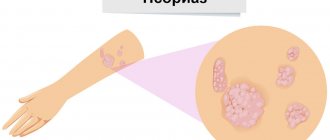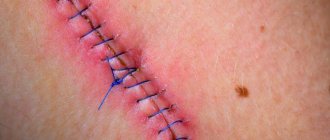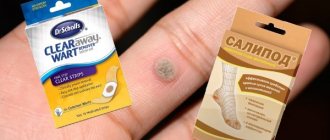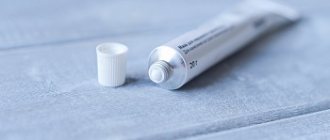Anti-callus patches
To speed up healing, you can use a special anti-callus patch:
- Compide - suitable for wet and dry corns, relieves pain, promotes rapid recovery;
- Leuko - disinfects, accelerates healing, prevents the penetration of bacteria;
- Salipod - softens keratinized tissue, suppresses inflammation, and has regenerating properties.
If the blister interferes with walking, and the patch does not reduce pain, then you should not wait for natural healing. In this case, it is necessary for the dropsy to burst. To do this, you need to carry out the following manipulation:
- disinfect the corns and nearby skin;
- make several punctures with a thin needle;
- let the liquid drain out, squeeze out the remaining residue with a dry cloth;
- Do not tear off the skin, but press it tightly to the wound and lubricate it with healing ointment (Levomekol, Bepanten).
httpv://www.youtube.com/watch?v=embed/_GOwpZT5Xc0
Fast Healing Products
There are many pharmaceutical and folk remedies that are recommended to be used to smear calluses for quick healing if the surface of the blister is damaged:
- “Rescuer” ensures rapid healing and protects against suppuration;
- “Synthomycin liniment” helps to heal a wound during an inflammatory process;
- Vishnevsky balm is used to quickly cure purulent pathology;
- If you anoint the affected area with 10% Salicylic ointment, the treatment of wet calluses will be accelerated;
- To quickly cure inflamed dropsy, Levomekol ointment is used;
- For faster healing, it is recommended to treat a callus that has torn with an oil tincture of the herb St. John's wort (pour a glass of raw material into 0.5 liters of any vegetable oil and leave in the dark for 3 weeks). The pathology is treated by applying a gauze bandage soaked in the composition to the problem area.
Before applying pharmaceutical products to broken calluses on your feet, you must carefully read the instructions and follow their recommendations.
Diagnostics
Water calluses on the feet are diagnosed as follows:
- an examination is carried out by a dermatologist
; - You may need additional consultation with a rheumatologist
, podologist or
orthopedist
.
Calluses should not be confused, for example, with inflammatory changes in joints, pinched nerves, inflammation of hangnails, genetically determined keratinization of the skin, and warts.
When diagnosing water callus, it is important to determine whether the patient has concomitant diseases. For example, varicose veins, diabetes mellitus, venous insufficiency, neuritis and so on.
Signs of infection and treatment options
The inflammatory process when pathogenic microorganisms enter the wound from a burst callus is characterized by the following symptoms:
- Painful redness around the callus;
- Tumor of the problem area;
- Increased temperature of the whole body;
- Suppuration of the wound surface.
How to anoint a burst callus:
- Cut the spines along the edges of the aloe leaf and peel off the skin from the concave side. Apply the fleshy part to the wound and apply a gauze bandage. It is advisable to do the procedure at night;
- Apply a piece of Kalanchoe leaf, after removing its skin, to the inflamed wound;
- Before going to bed, steam the affected heel or toe in a warm solution of potassium permanganate. Wipe your leg dry, apply a plantain leaf, and apply a sterile bandage on top.
What do we need to treat a torn callus?
- Hydrogen peroxide- antiseptic (at the pharmacy the price is maximum 10 rubles).
- BF-6 glue is a combined dermatoprotective agent that has an antiseptic and wound-healing effect. Isolates the wound surface from the external environment (price in the pharmacy from 50 rubles).
- Panthenol is an ointment for external use for the treatment of wounds, a good stimulator of regeneration (price in the pharmacy from 39.00 rubles).
First aid
A callus can appear on any part of the foot, but the heel is most often affected. How to quickly cure a callus that has burst on the heel:
- Remove the affected leg from shoes and clothing (socks, tights);
- Wash your hands with soap;
- Gently wash the area around the lesion with warm water and soap, being careful not to get any liquid into the wound;
- Treat the burst callus with any antiseptic (furatsilin solution, hydrogen peroxide, light pink solution of potassium permanganate);
- If the liquid inside the wound is free of blood, and the callus itself has not affected a large area of skin, you can fill the wound with BF-6 medical glue. The burning pain lasts literally 1-2 minutes. But then the wound is covered with a thin protective film, which prevents infection. A bactericidal patch should be glued on top of the treated surface;
- If the affected area is large, the wound should be smeared with antimicrobial ointment (Levomekol, Streptotsidovaya, Liniment synthomycin, etc.). Then it is recommended to apply a sterile bandage, which must be changed 2-3 times a day, while the ointment will protect the wound from infection by microbes and the bandage sticking.
Is it possible to smear calluses with brilliant green and iodine? This is of interest to patients who often develop dropsy. If you use the product on an open wound, you can get burned. In addition, the drugs greatly dry out delicate skin, causing cracks to appear on it.
If the surface of the dropsy is not broken, treatment is carried out using disinfecting compounds over the skin covering the wound. Zelenka protects it from inflammation. Potassium permanganate is used for daily baths, which speed up healing.
What to do if a callus on your foot bursts outside the home:
- Apply a plantain leaf to the wound with the glossy side, after washing or wiping it from dust and dirt. Put a sock on top;
- Pluck several carved yarrow leaves, chew them thoroughly until a homogeneous mass is obtained, and cover the wound with the resulting composition;
- If you don’t have familiar medicinal plants at hand, stick a leaf of birch, oak, poplar, or maple on the affected area;
- Remove the shoes that are rubbing your feet, otherwise the blister may break.
Arriving home, you should quickly and thoroughly treat the callus that has burst on the heel.
Ways to prevent formations
Treating water callus is much more difficult than preventing its formation. To avoid rubbing dropsy, it is recommended to comply with the following requirements:
- It is advisable to break in new shoes using a special product to soften them;
- use “footprints” so that the heel does not rub;
- Don't put on shoes if your feet are wet.
The problem area should heal in no more than 2-3 weeks. For inflammation that lasts longer, the patient should visit a doctor (dermatologist, surgeon).
A wet callus, if it bursts, causes pain and discomfort to a person, so you should not delay treatment and a visit to the doctor. To prevent the development of a pathological process, if you notice increased friction, stick a piece of adhesive tape on the problem area. It is recommended to select shoes according to your foot size and wear them at the appropriate time according to weather conditions. Compliance with hygiene rules reduces damage to the feet by calluses.
What to do to get rid of the disease
Piercing
To prevent the rupture of a large bubble, the dropsy is punctured. They do this only if it itself can break through at any moment, and also causes severe pain and discomfort.
Before puncture, the subcutaneous bladder is disinfected. The instrument is disinfected along with the callus. Alcohol or hydrogen peroxide will do. They have an anti-inflammatory effect. You can replace alcohol with iodine. Use sterile medical needles or processed sewing needles. Alcohol or fire calcination are also used to sterilize needles.
The needle is held parallel to the water calluses, on the side. You cannot pierce from above. This will cause a deep wound and fundal irritation.
It should be pierced on the first day after the watery blister appears.
One or two punctures will help release the fluid from the bubble. They will ensure constant outflow. Care must be taken to ensure that the lower layers of the skin are not overexposed. The walls of the bladder are preserved. They will prevent the spread of infection.
Then a local antibiotic is applied to the water calluses. Use the dosage recommended by the doctor and apply a protective patch. Replacement with a new one is required twice a day. If the callus appears again, then the puncture is done again.
When water calluses rupture with detachment of the wall, anti-bacterial ointment is applied to the cleaned wound. Next, secure it with adhesive tape.
Doctors and traditional medicine do not advise making punctures on small formations. The bladder protects against infections.
Using soap and soda solution for baths
To speed up the healing of calluses on the foot, baths are used. Add one teaspoon of baking soda per liter of water. Four to five shavings of soap are cut into warm water. The duration of the procedure is 15-20 minutes. Until healing, it should be performed every day.
The second way to remove callus is to use potassium carbonate (potash). A solution of a crystalline substance of 10% per liter of water is also mixed with soap.
Removal with callus plaster
A ready-made preparation containing salicylic acid, rosin, paraffin and petrolatum will help get rid of the disease. It prevents contamination and the spread of infections. You can use propolis adhesive plaster. As a rule, the callus goes away on its own within 3-5 days.
Application of callus fluids
This is a combination medicine for removing water callus. Contains alcohol, collodion, brilliant green and salicylic acid. Apply after a hot bath for a week.
Following the advice of traditional medicine
- Aloe leaves. The bandage is applied as follows: the core is bandaged onto the water callus; the bandage should not be removed until the morning. After the bandage is removed, lubricate the sore spot with a nourishing cream.
- Grease with onion and garlic juice. Squeeze out the juice, mix and lubricate the calluses.
- Fresh potatoes. You need to rub it and apply the resulting pulp to the wound.
- A slice of lemon. The legs are steamed, lemon is applied and secured with a bandage. The bandage is kept on the foot until the morning.
Plants that can speed up the healing process: Robert's geranium, forest geranium, river grass, common oak, creeping tenacious, goat willow, meadow clover, large burdock, coltsfoot, roofing sapling, Euphorbia, Dandelion officinalis, large sedum, caustic sedum , Purple sedum, Greater celandine.
In general, therapy is aimed at softening the tissue. It will allow you to easily remove watery calluses. The keratolytic properties of the substances have a softening effect on the tissue of the bladder wall. Handy tools will help in removal.
If the callus does not go away and continues to bother you, you should consult a doctor. He will treat the opened bladder and recommend drug treatment.
Following the specialist’s recommendations will shorten the healing time of the callus. It is necessary to contact a surgeon and treat the affected areas. Often healing goes away on its own. In case of severe inflammation, it is removed surgically.
httpv://www.youtube.com/watch?v=embed/VWh8M9-as_A
Treatment of calluses with traditional methods
Steaming the callus in a bath of warm water promotes rapid healing. For 3 liters you need to add 2 large spoons of baking soda and 1 - dried chamomile. Soak the foot in water for 10-15 minutes, spread it with Salicylic ointment, and seal it with a special plaster.
There are several ways to prevent the callus from becoming inflamed:
- Apply a cross-cut aloe leaf to the damaged area for 2-3 hours.
- Potato juice, which is applied as a lotion for 2 hours twice a day, relieves swelling, reduces pain and promotes healing.
- Propolis, added to baby cream in a ratio of 1:5, is applied to the wound, after which a bandage is applied. When using this method, an allergic reaction is possible, so during the first use you need to carefully monitor changes in skin condition.
The corn has burst, what should I do?
If your dropsy suddenly bursts, you should wash your hands thoroughly and disinfect the edges of the wound with an antiseptic so that the product does not get on the opened area - this will slow down the healing process. Then cover the wound with adhesive tape.
After disinfection, broken wet calluses on the heels can be sealed with an anti-callus plaster. It absorbs excess lymph fluid without preventing air from entering the wound and the burst dropsy heals faster.
To obtain a positive effect, you need to correctly apply an anti-callus adhesive plaster to the burst blister on the heel:
- Using treated manicure scissors, cut off the dead edges of the skin;
- Wipe the wound with a cotton pad soaked in clean water, after which the wound must be wiped dry;
- stick the patch on and do not remove it. It will fall off on its own when the wound heals.
Attention! Without consulting a doctor, the patch is not recommended for use by people with diabetes. A wet callus has burst, but there is no band-aid? In this case, you can use pharmaceutical drugs that have antimicrobial and anti-inflammatory effects, and also have a healing effect
By following the instructions you can achieve a positive result
A wet callus has burst, but there is no band-aid? In this case, you can use pharmaceutical drugs that have antimicrobial and anti-inflammatory effects, and also have a healing effect. By following the instructions, you can achieve a positive result.
How to choose the right ointment against calluses?
In home treatment, the drug is selected taking into account the type of callosal defect:
- Ointments with a moisturizing, softening, and keratolytic effect will help with corns and dry calluses. Therapeutic agents enhance desquamation - exfoliation of dead skin flakes, activate blood microcirculation, and soften damaged areas.
- For shallow core calluses, keratolytic preparations are used to loosen the keratinized epidermis, and local anesthetics to eliminate pain.
- For water calluses, burst blisters, and areas worn down to the flesh, use antibacterial anti-inflammatory drugs that have a drying and wound-healing effect. And also, reparants and regenerants for skin restoration.
For bloody calluses resulting from tissue compression, treatment with antiseptics is necessary. An infection easily penetrates into a burst blood callus, which can lead to suppuration, inflammation of the lymph nodes, and sepsis (blood poisoning).
Benefits of ointment treatment:
- accessibility (you don’t need a doctor’s prescription to purchase the product);
- therapeutic effect to accelerate the healing of the epidermis;
- wide choice of directional action;
- acceptable price category.
Important!
Medicines for external use do not have direct contact with the digestive organs, which significantly reduces the list of contraindications for their use. When self-treating with topical drugs, you must:
- follow the instructions for use;
- before use, perform an allergy test on the inner bend of the elbow joint;
- After opening the package, store the ointment in the refrigerator.
What to do if a callus on your foot bursts
Wet (water) calluses often appear on the soles of the feet, especially in the summer. Rubbing dropsy is quite simple: small pebbles or sand get into the gap between the skin and the shoes. As a result, a watery layer is formed between the layers of the epidermis, swollen with a bubble. You should not allow the dropsy to burst prematurely, since the “water” that fills it has bactericidal properties. It protects the nascent young skin from inflammatory processes and pathogenic microorganisms. But what to do if a callus bursts on your foot? To answer this question, you need to know how to treat burst calluses to avoid infection.
A burst callus can cause a lot of trouble due to the resulting pain and the possibility of inflammation, and then suppuration due to infection at the site where the integrity of the vesicle is broken. Quickly healing a burst callus means preventing the onset of the inflammatory process.
Wound care
Open wound
Calluses can be especially painful on the back of the foot. Over time, it becomes hard and yellowish. It cannot be brought to such a state. This thickening of the skin layer threatens to stay with you forever, causing severe pain.
In this case, treatment means the use of antiseptics. It is worthwhile to dwell in more detail on wound care.
In a hot soda bath, steam the skin of your feet and remove excess skin layers on the surface. Then, in order to protect healthy skin from the diseased skin, we apply zinc paste, an adhesive plaster or 10% salicylic, lactic acid in collodion near it. We leave it like that for a day.
The procedure requires repeated repetition until all thickenings disappear. If the proposed method does not help, it means that the disease has gone too far and you need to resort to surgical intervention.
You can also use proven folk remedies:
- aloe leaf, cut - draws out liquid well and dries;
- lemon - slice;
- bread crumb with vinegar (3%);
- potatoes, pre-grated;
There are quite a lot of medications and ointments for treating calluses and other growths on the feet. They contain salicylic acid and benzoic acid. It is important to remember that cream should not be applied to healthy skin.
If the callus has burst, safety measures have already been taken and a bandage has been applied, all that remains is to monitor the recovery. The bandage should be changed several times a day. Before changing the fabric, you need to wet it so as not to tear it off along with the healing skin crust. It is advisable to use hydrogen peroxide.
What types of calluses can there be on the heels?
A callus or callus is a compacted area of skin with sharply defined boundaries, causing pain, which is formed as a result of long-term contact with a mechanical irritant. On the heels, it most often occurs upon contact with shoes.
The appearance of calluses can also be caused by factors such as excessive sweating on the feet, improper foot care and poor footwear. There are people who have an innate tendency to form calluses. They have a low subcutaneous fiber content, which leads to the appearance of calluses even with slight friction.
- Bone - a formation that appears as a result of bone renewal after injury, during the natural process of healing of a fracture. Forms at the site of injury in the form of a connective tissue scar;
- Spurs or calluses;
- Skin - is formed through prolonged exposure to an irritant on the skin and happens:
- wet (dropsy or soft callus);
- hard or dry (corns);
- pointed.
Dropsy is a blister that forms under the top layer of skin and is filled with fluid (lymph). It can also be bloody - filled with blood and purulent, containing pus. Causes pain and discomfort, but does not pose a threat to life. However, when neglected, it can become a source of infection for the entire body.
If mechanical impact continues on the dropsy, it may acquire a hard (dry) appearance.
Hard calluses or corns occur on the heels due to constant pressure. It is implicit, so it does not cause discomfort. At the point of contact, the skin becomes rough, forming a keratinized layer of epithelium. It doesn't hurt and hardly bothers me. However, in an advanced stage, it begins to crack and these cracks spread to healthy areas of the skin, and then severe pain is felt.
A pointed or core callus has a hard rod in the center that grows deeply into the lower layers of the epidermis, causing severe pain when walking. If you do nothing, then over time it will become deeply rooted, and its surface will crack, the pain will become unbearable and will greatly complicate life.
Read more about the treatment of dry calluses with a core in this article.
Prevention methods
Callus after removing the patch
Often we simply do not have enough time to treat such ailments as not serious at first glance, such as a callus. But our carelessness is fraught with consequences. The body's immune system continues to weaken. A person does not notice how the appearance of calluses becomes the norm.
A weakened body contributes to the “waking up” of many complex diseases. An ordinary neoplasm on the skin of the foot can, in an advanced state, lead to damage to the central nervous system. These are quite rare cases, and are observed only in cases of acute neglect of the disease, in the absence of any preventive measures.
Periodic weight checks refer to the prevention of not only calluses, but also corns and spurs. Proper nutrition is important, as is an active lifestyle. Pay attention to comfortable shoes without rough seams, give preference to products made from genuine leather. Hosiery should not be synthetic, but cotton, well breathable.
Prevention includes: frequent changes of underwear, daily timely foot care (shower, hardening - contrast baths) This is a good help in the fight against many skin tumors and ailments.
Main symptoms
The main manifestations are pain and difficulty walking.
Constant pressure leads to redness of the skin, swelling, and noticeable pain. A subcutaneous bubble forms. It fills with clear body fluid. The walls are tense.
When damaged, the water callus opens and fluid flows out. An opened watery callus can lead to severe inflammation. In some cases, abscesses form - purulent infections. They can develop in subcutaneous tissue, muscles, bones, and organs.
Tearing of the bladder wall increases the risk of contracting a staph or streptococcal infection. This is evidenced by larger redness, pain without friction, additional yellowish formations, pus, and increased temperature. Treatment depends on the stage of development.
Reasons for appearance
Calluses can appear for the following reasons:
- Wearing uncomfortable shoes. Shoes or boots with a hard heel will certainly cause the appearance of calluses near the heels, which will subsequently lead to roughening of the skin. If we are talking about high-heeled shoes, then chafing may appear on the plantar part of the foot (near the toes).
- Hyperhidrosis of the feet. Excessive sweating of the feet leads to constant exposure of the skin to a damp environment. Because of this, wet calluses are formed, which are prone to frequent ruptures.
- Flat feet. Provokes a strong uneven load on the entire foot.
- Large body weight.
- Prolonged work on your feet.
- Hyperthyroidism. Increased secretion of thyroid hormones, which leads to dry skin, making it more susceptible to calluses.
- Fungal infections. They corrode the skin of the feet, drying it out, as a result of which damage occurs much more often.











